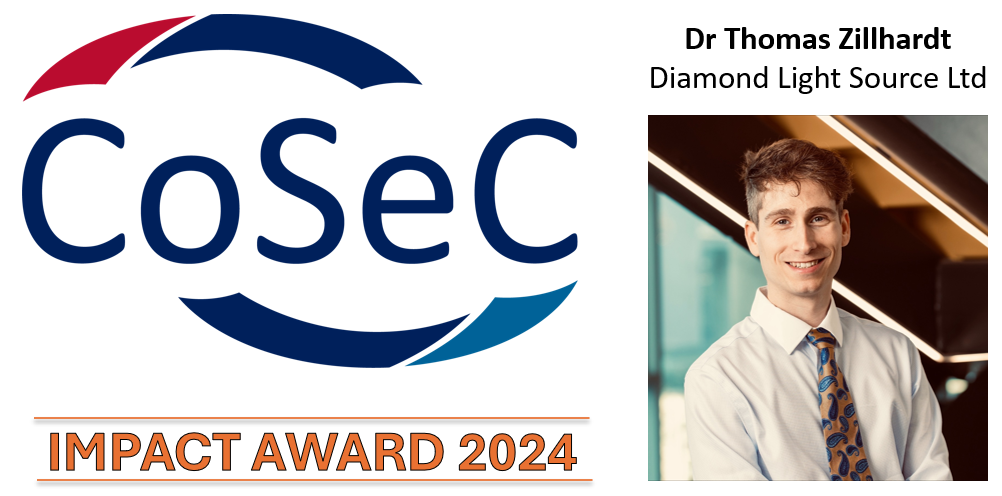
Congratulations to the winner of the 2024 CoSeC Impact Award...
Dr Thomas Zillhardt
Diamond Light Source Ltd
The CoSeC Impact Award is s means of recognising the research of Masters or PhD students, or early career researchers with up to 5 years post doctoral experience supported by CoSeC, while at the same time raising awareness of the CoSeC communities. It is also a means of acquiring evidence of the impact of CoSeC and the communities it supports on science, society and the economy.
The winner of this year's award was chosen by an external panel for his work on "QUANTUM DIGITAL TOMOSYNTHESIS".
Abstract: At the University of Manchester, and in partnership with Adaptix Ltd and Kromek Plc, I lead a project to design, assemble and test the first hyperspectral X-ray tomosynthesis scanner. This fast virtual serial sectioning modality makes use of recently developed flat panel X-ray sources, whist hyperspectral X-ray imaging is made possible with new direct-conversion photon counting detectors. Two detector technologies have been selected from the CERN-Medipix family: a charge summing and allocation multi-spectral detector and a single-photon counting hyperspectral detector. This led to two prototypes, the first one dedicated to biological samples, and the second to engineering and materials specimens. The reconstruction codes were developed from the Core Imaging Library (CIL) from CCPi specifically for this project.CCPi had previously collaborated with a PhD student at the University of Manchester to create a reconstruction routine for hyperspectral tomography, for data acquired with the HEXITEC detector. I early on started getting involved in activities organised by the CCPi team, including the workshop at the IOP and the hackathon in Cambridge. Whether on events or online, I received support from the CCPi team to better understand the algorithms and debug my code. I went on to start implementing tools to import and pre-process the data on a notebook with the CIL. Then, the essential part was to accurately define the geometry, as the source can be seen as an array of point sources in a plane, with sample and detector staying fixed, which is significantly different from a conventional cone-beam or parallel beam CT geometry. This proved to be successful and compared well with an industrial tomosynthesis reconstruction code. The advantage of working with CIL was the flexibility of using non-proprietary code and the ability to then take the spectral multi-band reconstruction forward.
Impact: There is an immediate benefit to the research community, as two new hyperspectral scanners using the code developed with CIL are now part of the National X-ray Computed Tomography (NXCT). These prototypes are available for research and testing within the UK scientific community. They use slightly different technologies, with one being dedicated to the life sciences and the other for Non-Destructive Imaging (NDT). With scan times down to a few minutes with very-low operational costs, they are an ideal tool for researchers and students to have a quick look inside their samples with material and tissue discrimination. As they are prototypes, further development is currently being carried out to improve image quality and automatic segmentation routines aided with IA. These prototypes are also suitable for outreach projects as they are easy and safe to use, almost as readily as a 3D printer.
Beyond research and academia, this technology provides far-reaching new capabilities for the medical sector and for industry.There is widespread evidence of the problems arising from excessive X-ray exposure (e.g., from cancer screening, and in the case of Breast Conserving Surgery (BCS), re-excision rates have been estimated to be more than 17% in the U.K. and Ireland. In over more than 17,000 patients with stage I-II cancer between 2012 and 2015 in the USA, 22.6% required a re-excision after BCS [6]. It is often difficult to differentiate healthy from diseased soft tissue with conventional imaging as the density contrast is usually poor. These modalities are often not a definitive diagnostic tool, and histopathology can take days to process excised tissue samples.
Quantum Digital Tomosynthesis (QDT), empowered by CIL, offers the ability to differentiate materials and tissue types, providing reliable results in minutes directly inside the operating theatre. This has the potential to reduce re-excision rates by offering accurate visualisation of resection margins in excised tissue, thereby reducing re-excision rates and with-it decreasing patient stress, improving patient outcome, and lowering costs to hospital services.These tools are equally applicable to the areas of engineering and materials science, with the second prototype, and with opportunities in Additive Manufacturing (AM), battery quality control and digital twining. Indeed, X-ray CT and material characterisation has showed both structural and chemical quality issues in commercial batteries, however this required disassembly. QDT is capable of fast non-destructive characterisation on many samples, providing statistics on the quantity and nature of defects other quality control measures fail to identify.
Research has demonstrated that metrology with conventional X-ray imaging of AM parts is affected by subjective interpretations, bias and inappropriate experimental parameters, all of which can be compensated with this advanced modality. Reverse engineering using micro-CT has allowed the improvement of AM processes by deforming the associated CAD model, and QDT can probe for impurities and production defects, in a much shorter timeframe than conventional CT.
